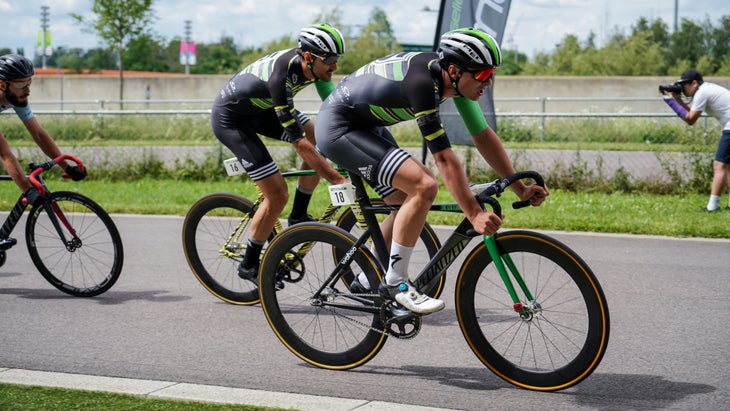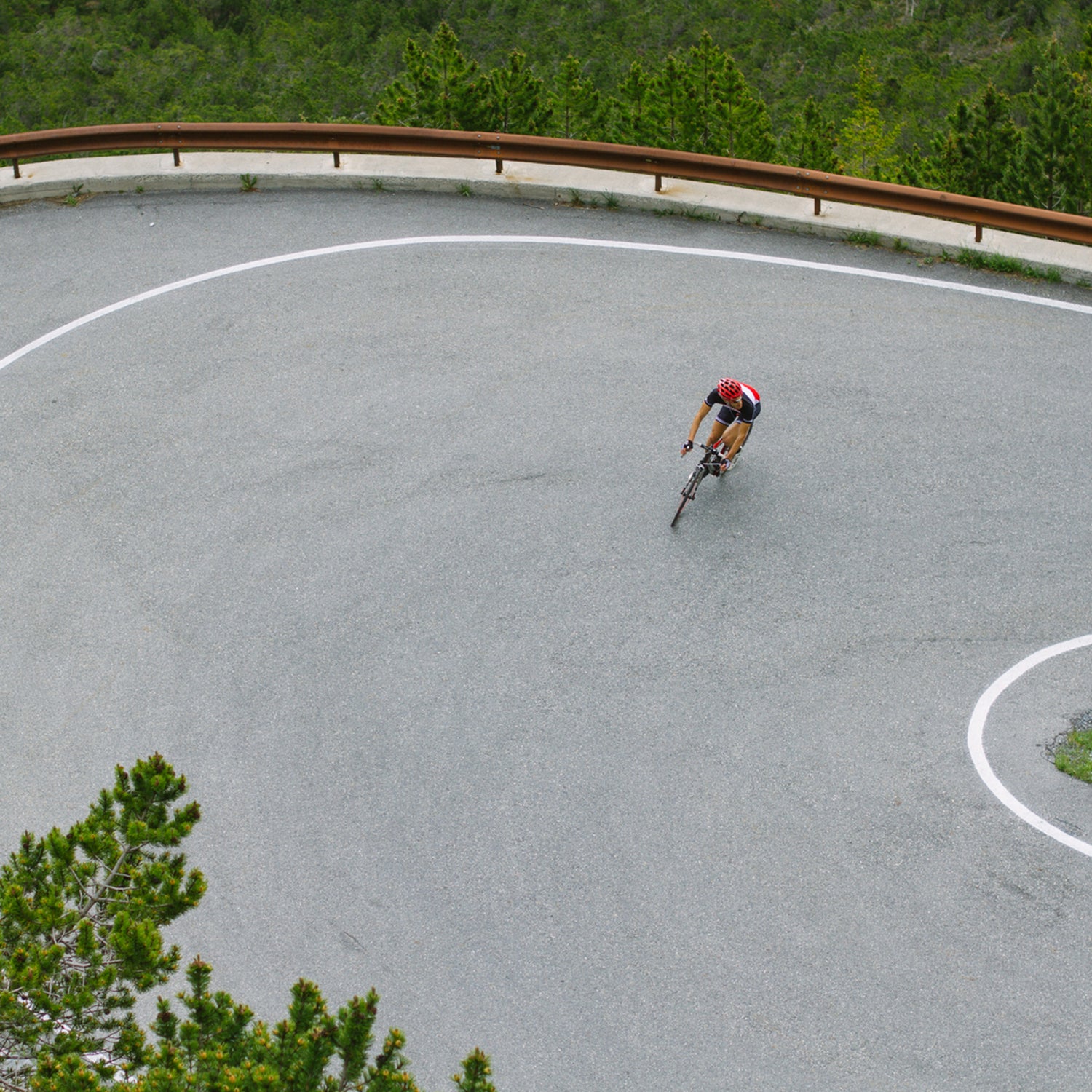Earlier this year, scientists in Norway published about a cyclist named Oskar Svendsen who, as an 18-year-old, recorded the highest ever value in a VO2 max test, won the world junior championships a few weeks later—but then, after a short and underwhelming stab at a pro career, retired before his 21st birthday. (I wrote about the report here.) As amazing as Svendsen’s lab-measured aerobic power was, there was an unspoken question that lingered about his rise and fall: why wasn’t he a faster cyclist?
A in the Journal of Applied Physiology, from Mikael Flockhart and Filip Larsen of the Swedish School of Sport and Health Sciences, takes a stab at this question—and in doing so, offers a provocative take on a much bigger and more general riddle about the best way to train for endurance sports. In essence, Flockhart and Larsen point out the harsh truth that Svendsen’s efficiency was terrible. He had a Ferrari engine, but it guzzled fuel wastefully. And that, they argue, was no coincidence.
High VO2 Max v. Efficiency
Physiologists have been wondering for a long time whether there’s a trade-off between having a super-high VO2 max, which means you’re able to burn through aerobic energy at a very high rate, and having good efficiency, which means you get the most bang (i.e. running or cycling speed) for each unit of aerobic energy that you burn.
For example, back in 1991 when Michael Joyner of the Mayo Clinic published on the ultimate limiting factors in marathon running, he calculated that a runner with very high but realistic values of VO2 max, running economy (a measure of efficiency), and lactate threshold should in theory be able to run a sub-two-hour marathon. But it wasn’t clear, he acknowledged, whether finding someone with best-of-the-best values of both VO2 max and running economy was merely unlikely, or whether there was some physiological reason that you wouldn’t hit the jackpot twice: “It may be,” he wrote, “that high VO2 max values are incompatible with excellent running economy.”
Joyner cited some data from earlier studies suggesting that, all else being equal, runners with higher VO2 max values tend to have lower running economy values and vice versa. Flockhart and Larsen point out that the data on Svendsen, which includes a series of eight lab testing sessions over a five-year period, offers a longitudinal test of the same question.
Sure enough, Svendsen’s gross efficiency—the power he was delivering to the bike pedals divided by the rate at which he was burning calories, essentially—was highest before he even started serious training for cycling, at 21.5 percent. Once he started training and his VO2 max started climbing to record levels, his efficiency dropped to between 19.8 and 20.5 percent. Then once he quit cycling, his efficiency increased again to 22.0 percent as his VO2 max dropped. In other words, every time his VO2 max increased, his efficiency got worse, and vice versa.

How Muscle Cells Produce Energy
This apparent trade-off has been a topic of debate and discussion for decades, but what’s missing has been an explanation for why it happens. Flockhart and Larsen, it turns out, have a possible explanation. They’re among the co-authors of another paper, , that does some very detailed modeling of how our cells manage their energy production to meet the demands of sustained exercise. (Larsen is the chief science officer of a company called Silicon Valley Exercise Analytics, and the company’s website has explaining the findings.) The biochemistry gets pretty messy, but they believe they’ve found a smoking gun in something called “complex I.”
The key point to understand is that your muscle cells face a constant trade-off between maximizing how much energy they produce and maximizing how efficiently they produce it. There are several different metabolic pathways that your cells can use to generate ATP—the basic fuel for muscular contractions—from stored energy sources such as carbohydrate and fat. If you head out for a slow jog, your cells will automatically select the most efficient metabolic pathway, so that your fuel supplies will last as long as possible. But as you pick up the pace, you’ll eventually reach a point where these efficient pathways can no longer generate ATP quickly enough to keep up with your muscles’ demand—so they’ll switch to a less efficient metabolic pathway that can generate ATP more quickly, but will also burn through your fuel stores sooner.
The CImax Threshold
In broad strokes, we can think of these two extremes as aerobic and anaerobic efforts, roughly separated by the lactate threshold. But the transition between those states isn’t like flipping a switch. Instead, there’s a gradual shift in the mix of metabolic reactions as your cells try to maintain as much efficiency as possible while meeting the demand for ATP. It turns out that there’s actually another threshold that you reach well before your lactate threshold. Larsen and his colleagues call this threshold “complex I max,” or CImax for short, and it marks the point where you body first starts to abandon its most efficient metabolic mode. In the trained cyclists in Flockhart and Larsen’s study, this occurred around 55 to 65 percent of maximum heart rate.
Complex I is a group of proteins in the mitochondria that play a crucial role in the aerobic production of ATP. At the CImax threshold, these proteins are operating at full capacity and can’t produce ATP more quickly—so, according to Flockhart and Larsen’s model, your cells begin to bypass complex I, opting for faster but less efficient ways of generating ATP for high-intensity exercise. In other words, Larsen says, “we have to ‘waste’ some energy to hold a competitive pace.”
That explanation focuses on what happens during a single bout of exercise, as your body struggles to balance efficiency and power. But what happens over longer periods of time, as you stress your body over and over? You can divide endurance training adaptations into two broad categories: you get better at delivering oxygen to your muscles; and your muscles get better at using that oxygen. Both are important, but their relative importance depends on your goals.
If you do a lot of VO2 max-style training—hard intervals lasting three to five minutes, say—you’ll preferentially improve your cardiovascular system so that you can deliver more oxygen to your muscles. This will increase your VO2 max. But if you haven’t similarly increased the mitochondrial capacity in your muscles, this also means that you’ll max out your mitochondria and hit CImax sooner. This, Larsen suggests, is what was happening to Svendsen: the training that sent his VO2 max through the roof also made him less efficient.
Conversely, while no one has actually tested how to “train your CImax,” Larsen hazards a guess that long, low-intensity training sessions would shift the adaptive focus to the mitochondrial capacity of your muscles. You wouldn’t see as much gain in VO2 max, but you’d burn your fuel more efficiently. If you’re a 5K runner, you probably want all the VO2 max you can get, regardless of any efficiency penalty. If you’re an ultramarathoner, it’s the other way around. If you’re Oskar Svendsen—well, it’s too late to worry about that now, but perhaps somewhere in the middle would have been best.
On the surface, it’s not particularly earth-shattering to suggest that 5K runners should do shorter and more intense training than ultrarunners. Horses for courses, as the British say. But there’s something beyond the usual platitudes here. If Flockhart and Larsen are correct, hammering VO2 max intervals over and over isn’t just a missed training opportunity for long- and ultra-distance athletes. By increasing the mismatch between oxygen supply and uptake and consequently hastening the onset of the CImax threshold, it may actually decrease your efficiency at race pace. Eventually, Larsen suggests, coaches may do periodic testing of the CImax threshold to see if it’s improving, or least not getting worse, over the course of a training block.
A final thought about putting these ideas in context: suggesting that an overreliance on VO2 max-focused training may have negative effects on efficiency is not the same as saying that ultra-distance athletes shouldn’t do VO2-max focused training at all. It’s important to note that Svendsen’s overall performance did improve as he got fitter, even though his efficiency got worse. But the new findings suggest that pushing your training too far to either extreme of the power-efficiency spectrum may backfire. And they remind us that becoming a champion endurance athlete doesn’t require an off-the-charts VO2 max—in fact, you may even be better off without it.
For more Sweat Science, join me on and , sign up for the , and check out my book .


